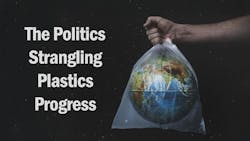“Clothed in plastics from head to foot, the American of tomorrow will live in a plastics house, drive a plastics auto and fly in a plastics airplane.”
That was the opening sentence to a Popular Mechanics article from 1940 called “The Era of Plastics.” A year earlier, the New York Times published an article discussing the possibility of using plastics in airplane wings and fuselages.
Back then, people saw the potential of plastics as a lightweight, durable material for nearly every application imaginable. The Popular Mechanics article included a laundry list of plastics uses: automobile steering wheels, protective lenses and goggles, fly fishing boxes, lamp shades, cockpit enclosures, gun turrets, dentures and so on and so on.
Plastics did indeed grow over the next eight decades to become pervasive in everyday materials. In 1940, annual plastics production in the U.S. was an estimated 160 million pounds per year, with 13 different types of plastics on the market, as noted in “The Era of Plastics.”
By 2018, U.S. plastics production reached 35.7 million tons. Today, vehicles average 50% plastics by volume, accounting for 10% of the auto’s weight, according to the American Chemistry Council.
The advances in plastics technology have brought remarkable benefits—from life-saving medical devices to lightweight vehicle components that improve fuel efficiency. But this plastics revolution has created a problem that the “Era of Plastics” did not foresee: a global waste crisis that’s placed producers on the defensive.
This week, in Geneva, Switzerland, negotiators from countries around the world met to finalize a global plastics treaty. They continue to sputter along, with no agreement reached by the August 14 deadline, forcing talks to extend into the following day.
In March 2022, 175 nations agreed to develop a legally binding treaty on plastics pollution. The sticking point in past sessions has focused on plastics production. Nearly 100 countries support caps on plastics production, and some have even called for bans on certain types of chemicals used in plastics. According to recent reports, the talks are stalling due to differences on whether to target plastics production or to focus on waste reduction and recycling.
If you thought figuring out which items were approved for your curbside recycle bin was a challenge, agreeing on a plastics treaty has become so convoluted that several nations' frustrations may be the same response: Just throw it all in the garbage.
Maybe it’s indicative of diplomatic efforts today. Compromising is a dirty word — with industry groups, ideologues and politicians vacillating while the world burns.
Plastics have become an integral part of our daily lives and are key materials in solar panels, wind turbines and lighter, more fuel-efficient vehicles. Production caps or bans could slow the development of these technologies.
However, the environmental and health concerns from plastics waste and pollution are valid. Our oceans have become dumping grounds for plastic bags, water bottles and medical waste. Meanwhile, scientists are examining the long-term impact of microplastics, the tiny bits of plastic that end up in our food chain.
The chemical industry has advocated for more recycling efforts, with ACC President and CEO Chris Jahn saying on the social media platform X: “Plastics play a vital role in our economy. With the right systems in place, they can also be part of the solution. The global agreement must focus on keeping plastics in the economy and out of the environment—because that’s real progress.”
Despite industry commitments to recycling, the Trump administration has created implementation hurdles by essentially thumbing its collective nose at anything that smells “green.” Recent policy shifts have affected planned investments, with some companies forced to delay or reconsider major recycling facility projects. Changes to green-energy incentives led Eastman Chemical to postpone construction of its planned methanolysis plant in Longview, Texas—a facility that would have processed plastics waste into new materials.
The era of plastics doesn't have to end. Essential materials can coexist with a healthy planet. Getting there will require overcoming the extremes that plague political discourse today—the false choices between economic growth and environmental protection and the zero-sum thinking that treats innovation and regulation as enemies rather than partners.
These polarized positions lead to nothing but diplomatic deadlock, petulant social media posts and a suffering world choking on the very materials that once promised to improve our lives.
About the Author
Jonathan Katz
Executive Editor
Jonathan Katz, executive editor, brings nearly two decades of experience as a B2B journalist to Chemical Processing magazine. He has expertise on a wide range of industrial topics. Jon previously served as the managing editor for IndustryWeek magazine and, most recently, as a freelance writer specializing in content marketing for the manufacturing sector.
His knowledge areas include industrial safety, environmental compliance/sustainability, lean manufacturing/continuous improvement, Industry 4.0/automation and many other topics of interest to the Chemical Processing audience.
When he’s not working, Jon enjoys fishing, hiking and music, including a small but growing vinyl collection.
Jon resides in the Cleveland, Ohio, area.

